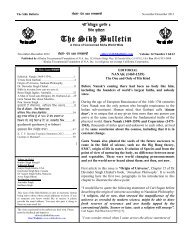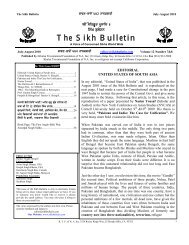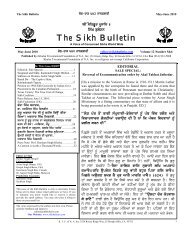Create successful ePaper yourself
Turn your PDF publications into a flip-book with our unique Google optimized e-Paper software.
<strong>The</strong> <strong>Sikh</strong> <strong>Bulletin</strong> hwV-swvx 537 June-July 2005<br />
objects and reasons was based on the experience of the <strong>Sikh</strong>s<br />
being addressed as ‘illegal children’ simply because their<br />
marriage ceremony was not recognized by the Hindus 5 .<br />
However, in the present, the Anand Marriage Act, 1909,<br />
though addressing this aspect, has fallen short of its intended<br />
objective of reducing the difficulties of the <strong>Sikh</strong>s and the<br />
relevance of the Act is itself doubtful.<br />
<strong>The</strong> first shortcoming of the Act, which is quite noticeable, is<br />
the absence of any provision for the registration of the<br />
marriages performed under the Anand Marriage Act, 1909.<br />
<strong>The</strong> Act is a brief piece of legislation containing only five<br />
sections. <strong>The</strong> purpose of the Anand Marriage Act at the time<br />
of legislation was only to validate the marriages performed<br />
with the <strong>Sikh</strong> ceremonies. By contrast, the Indian Christian<br />
Marriage Act, 1872, the Parsi Marriage Act, 1936 and the<br />
Hindu Marriage Act, 1955, all contain provisions for the<br />
registration of the marriages performed under those Acts.<br />
<strong>The</strong> marriages performed under the Anand Marriage Act<br />
are registered under the Hindu Marriage Act, 1955, or the<br />
Special Marriages Act, 1954. Registering a <strong>Sikh</strong> marriage<br />
under the Act titled as the Hindu Marriage Act is deemed by<br />
a majority of the <strong>Sikh</strong>s to be hurting to their religious<br />
sentiments and to their personal dignity. This is evident from<br />
the following news item:<br />
<strong>The</strong> 100-year-old marriage Act for <strong>Sikh</strong>s, the Anand Karj<br />
Marriage Act which was later repealed (sic) was discussed<br />
during the in-camera meeting between Giani Joginder Singh<br />
Vedanti, Jathedar Akal Takht and Mr Tarlochan Singh,<br />
Chairman, National Commission for Minorities (NCM)<br />
during latter’s visit here…. Both Jathedar Vedanti and Mr<br />
Mann told Mr Tarlochan Singh that <strong>Sikh</strong> girls and boys,<br />
especially from abroad, have been objecting to get their<br />
marriages registered under the Hindu Marriage Act 6 .<br />
On the other hand, the registration process under the Special<br />
Marriage Act, 1954, is comparatively cumbersome and<br />
discriminatory. For example, Section 15(d) of the Special<br />
Marriage Act puts a condition that the parties be at least 21<br />
years at the time of registration of the marriage whereas the<br />
marriageable age in India for females is 18 years only. So, if<br />
a <strong>Sikh</strong> female marries at the age of 18 years under the Anand<br />
Marriage Act, 1909, her marriage cannot be registered under<br />
the Special Marriage Act for another 3 years. Further,<br />
whereas no notice is required under the Hindu marriage Act<br />
for registration of a validly performed marriage, the<br />
registration process under the Special Marriage Act requires<br />
a public notice of thirty days. This is per se discriminatory.<br />
Thus, under the present circumstances, the pragmatic<br />
approach for registration of the marriages performed under<br />
the Anand Marriage Act is to get them registered under the<br />
Hindu Marriage Act. This causes a confusion regarding the<br />
religious identity of the <strong>Sikh</strong>s. Col. Amrik Singh (retd.)<br />
observes that the Anand Mar¬riage Act 1909 seems to have<br />
quietly lost its legal significance without it even being<br />
noticed by the <strong>Sikh</strong>s and now all marriages performed by<br />
<strong>Sikh</strong>s are registered as Hindu marriages 7 .<br />
Keeping in view such grievances of the <strong>Sikh</strong>s, and the basic<br />
objectives as enshrined in the Preamble of the Constitution<br />
of India, especially those declaring the values of freedom to<br />
worship, thought, fraternity and dignity, it is imperative that<br />
the provisions for the registration of marriages performed<br />
under the Anand Marriage Act be introduced in the said Act<br />
itself. <strong>The</strong> main grouse of the communities other than<br />
Hindus is with the title of the Hindu Marriage Act. Even<br />
those <strong>Sikh</strong> intellectuals who believe that the Hindu Marriage<br />
Act is in consonance with the <strong>Sikh</strong> ethos seriously debate<br />
the propriety of its title. S. Kashmir Singh points out that the<br />
only irritant is the title of the Act which gives the<br />
impression that all those governed by it are Hindus even<br />
though, according to him, the provisions in the Act are<br />
sufficiently clear to allay such suspicions and<br />
apprehensions. He holds:<br />
<strong>The</strong> contents of the Act show that it has not been correctly<br />
named. It requires a serious effort on the part of the<br />
legislature to mingle it with SMA and apply it to all the<br />
Indians taking a concrete step towards the Uniform Civil<br />
Code 8 .<br />
<strong>The</strong> second major reason for the Anand Marriage Act being<br />
of limited applicability is the exemption of marriages<br />
between a <strong>Sikh</strong> and a non-<strong>Sikh</strong> from the purview of the Act.<br />
Section 3(a) of the Anand Marriage Act states, “Nothing in<br />
this Act shall apply to- (a) any marriage between persons<br />
not professing the <strong>Sikh</strong> religion…” By contrast the Hindu<br />
Marriage Act has a much wider applicability. Section 7 of<br />
the Hindu Marriage Act provides: A Hindu marriage may be<br />
solemnized in accordance with the customary rites and<br />
ceremonies of either party thereto. Thus, whereas a marriage<br />
between a <strong>Sikh</strong> and a non-<strong>Sikh</strong> performed by the religious<br />
rites of Anand Karj is perfectly valid under the Hindu<br />
Marrige Act, the same is out of the purview of the Anand<br />
Marriage Act, 1909. This makes the Anand Marriage Act<br />
redundant is all such cases. People have found a novel way<br />
out of this situation. Bachittar Singh Giani, describing such<br />
a method, a circuitous one though, writes:<br />
Many cases have come to notice that the bridegroom being a<br />
<strong>Sikh</strong> and the bride a Hindu, parents of the couple agreed to<br />
solemnise the marriage first in the presence of Holy Aad<br />
Guru Granth Sahib reciting the four lavans, and on the next<br />
occasion according to Hindu rites. <strong>The</strong> solemnisation of<br />
marriage in such a manner can have effect both ways 9 .<br />
In order to bring the Anand Marriage Act at par with the<br />
Hindu Marriage Act in terms of its applicability, the Anand<br />
Marriage Act should be amended to incorporate provisions<br />
regarding validation of the Marriage between a <strong>Sikh</strong> and a<br />
K.T.F. of N.A. Inc. 3524 Rocky Ridge Way, El Dorado Hills, CA. 95762 10
















